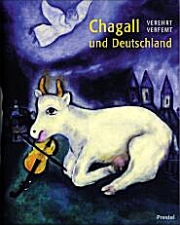|
Chagall and Germany:
Periods of reception by Chagall’s German audience
[DEUTSCH]
An Exhibition of the Jewish Museum of
Frankfurt am Main and of the Foundation Brandenburger Tor, Berlin Frankfurt - February 2nd – April
18th 2004 / Berlin - May 1st – August 1st 2004
Chagall and Germany – this subject is about
a complicated life-long interrelation between one of the most important modern
artists and a country that had undergone tremendous changes in the arts at the
beginning of the 20th century. However, it was to end abruptly later
on under the rule of National Socialism.
World War II and its breach of
civilization, which had occurred to a then yet unknown extent, had long-lasting
disturbing effects on the German identity and compelled the German nation after
1945 to undergo a new orientation in the arts and sciences.
Chagalls reception in Germany from 1913
until the present reflects all these disturbances in a seismographic manner.
Today his works of art have not only come to give testimony to these breaches of
civilization but have also become symbols of a universal humanism which crosses
the borders of various countries and cultures.
The exhibit at the Jewish Museum of
Frankfurt and at the foundation “Brandenburger Tor” in Berlin will present
Chagall from a new point of view by focusing on the cultural and historical
reception of his work, and by showing the artist’s reactions to these particular
occurrences.
Accordingly, Chagall’s pictures will be put
into a double perspective: they will be presented from the viewpoint of
contemporary collectors of art, patrons and artist colleagues and they will also
be simultaneously shown as documents of history.
The exhibition will be subdivided into
three parts, analogous to these periods of reception by Chagall’s German
audience:
Chagall as a modern Jewish Artist in
Berlin
As a distinguished Jewish artist of the
avantgarde, Chagall is supported by a small committed audience that collects his
works (1913-1933). Among his sponsors and patrons are prominent gallery owners
like Herwarth Walden, Paul Cassirer and Joseph Beer-Neumann. During Chagall’s
stay in Berlin (1922-23), he studies with Hermann Struck and Joseph Budko the
art of etching and woodcut that will open decisive new perspectives for his
artistic endeavours. He creates the series of etchings titled as "Mein Leben"
(My Life) under the patronage of Paul Cassirer.
"Degenerate Art" – the Artist Takes a
Stand Against Inhumanity
Chagall’s works had already come under
attack in 1933. With the beginning of 1938 they came to embody the idea of
"Degenerate Art" under Nazi rule. The confiscated works, which included many
masterpieces from his time in Paris, were sold abroad in exchange for foreign
currencies.
As a reaction to the Jewish people being
ostracized and also to the Shoah, Chagall created new works that are replete
with metaphors using crucifixion as the supreme notion of suffering as its
central theme.
Biblical Messages and Reconciliation
 After the Second World War the German audience begins to discover Chagall as a
modern painter. His artistic work paves the way to a great extent for the
general understanding of modern and also of abstract art. At the same time
Chagall’s biblical illustrations are prominently perceived to be a sign of
reconciliation. After the Second World War the German audience begins to discover Chagall as a
modern painter. His artistic work paves the way to a great extent for the
general understanding of modern and also of abstract art. At the same time
Chagall’s biblical illustrations are prominently perceived to be a sign of
reconciliation.
Zur
Ausstellung erschien im Prestel-Verlag ein umfangreicher, reich bebilderter
Katalog.
Stiftung Brandenburger Tor Berlin
Prof. Monika Grütters und Janet Alvarado, (030) 22633016 (janet.alvarado@bankgesellschaft.de)
Marc Chagall and Germany
hagalil.com 20-04-04 |